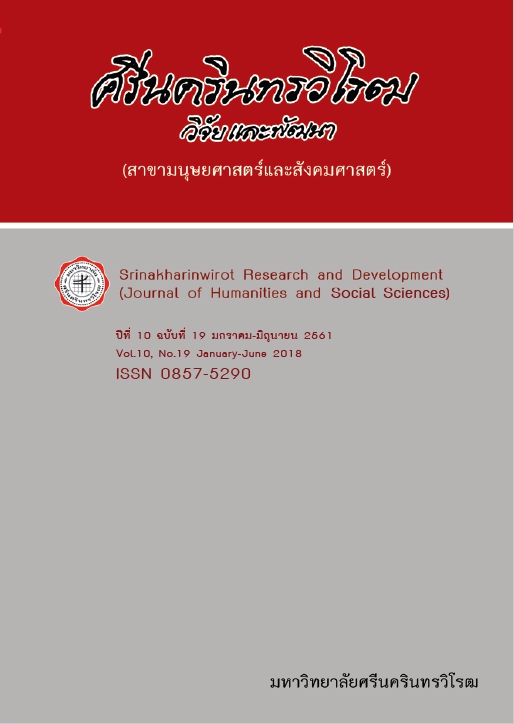รูปแบบการพัฒนาคุณลักษณะผู้นำที่มีความเชื่อมั่นในตนเองของนักเรียนนายสิบทหารบกเหล่าทหารราบ: โมเดลโค้งพัฒนาการที่มีตัวแปรแฝงสมการกำลัง 2 ลำดับที่ 2 (A DEVELOPMENT MODEL OF LEADER’ SELF-CONFIDENCE TRAITS OF NON-COMMISSIONED STUDENTS INFANTRY CROP: 2ND ORDER Q
Keywords:
Leaders’ Characteristic, Self-ConfidenceAbstract
This research was aimed to develop model of leaders’ self-confidence traits of non-commissioned student infantry crop. The research methodology is a mixed method. The research design was divided into 4 phases: the 1st phase (R: 1) to study the theory of leaders’ self-confidence trait and to develop model (Best practices). the 2nd phase (D:1) was the development model of development leaders’ self-confidence traits (Feasibility) for Prototype solution by using qualitative research and the research tools were interviewing, Observation and focus group. The 3rd phase (R: 2) was an experiment of using model (try out) to compare the growth rate between the control group and experimental group, and the 4th phase (D: 2) was a model improvement and implementation (final solution) by using quantitative research and the research tools by using model of development self-confidence leaders’ traits (Prototype) and questionnaire. The populations were 1,097 students of army non-commissioned, infantry corps, Infantry School. The samples were 70 students derived from the sampling method by G*Power statistical computer program and divided into 2 groups as control group for 35 samples and experimental group for 35 samples. The quantitative data was statistically analyzed by frequency, percentage, means, standard deviations, variances and Cronbach’s alpha using SPSS for Window and 2nd order quadratics LGM statistically analyzed by Chi-square: (c2), Relative Chi-square: c2/df), Degree of freedom (df), RMSEA, CFI, TLI, SRMR, Wald test(DS), intercept means (mi), slope means (ms), quadratics means (mq), intercept variances (s2i), slope variances (s2s), quadratics variances (s2q), slope-intercept co-variances (fs-i), quadratics-intercept co-variances (fq-i) and quadratics-slope co-variances (fq-s) using by Mplus computer program and the qualitative data was the content analysis.
The results found that (1) model of leaders’ self-confidence traits were 6 components to develop; Self-Efficacy, assertiveness, decisiveness, self-esteem, optimism, and adaptability for working environment by group process and relationship group activities, (2) In first period the experiment of using model of leaders’ self-confidence traits found that the growth rate of self-confidence leaders’ traits of experiment group was higher increased than the control group in all 6 components at the significant level of .05 but the growth rate decrease in the end (3) the evaluation of model development of self-confidence leaders’ traits by 2nd order quadratics LGM was harmonized with the empirical data. And (4) the research can be concluded that the development model can be able to solve the problem of lacking of student’ self confidence effectively in short time.
Downloads
References
[2] โรงเรียนทหารราบ. (2555). แผนแม่บทการศึกษา ปี พ.ศ.2555-2559. ประจวบคีรีขันธ์: ม.ป.พ.
[3] Child Study Association of America. (1952). Our Children Today. New York: The Viking Press.
[4] Breckenridge. Marine Edgar. (1995). Child Development. London: W.B. Saunders Company.
[5] Garrison. (1965). The Trooper. Garrison High School. North Dakota.
[6] ก้อง ไชยณรงค์. (2552). ผลของหลักสูตรเสริมสร้างคุณลักษณะผู้นำในรูปโค้งพัฒนาการที่มีตัวแปรแฝงของภาวะผู้นำเต็มรูปและทักษะผู้นำ: กรณีศึกษานักเรียนนายร้อย โรงเรียนนายร้อยพระจุลจอมเกล้า. ดุษฎีนิพนธ์ศึกษาศาสตรปรัชญาดุษฎีบัณฑิต มหาวิทยาลัยเซนต์จอห์น.
[7] วรรณี แกมเกตุ. (2551). วิธีวิทยาการวิจัยทางพฤติกรรมศาสตร์. พิมพ์ครั้งที่ 2. กรุงเทพฯ: โรงพิมพ์แห่งจุฬาลงกรณ์มหาวิทยาลัย.
[8] วรรณคดี สุทธินรากร. (2556). การวิจัยเชิงคุณภาพ การวิจัยในกระบวนทัศน์ทางเลือก. กรุงเทพฯ: สำนักพิมพ์สยามปริทัศน์ จำกัด.
[9] สุภางค์ จันทวานิช. (2540). การวิเคราะห์ข้อมูลในการวิจัยเชิงคุณคุณภาพ. พิมพ์ครั้งที่ 11. กรุงเทพฯ: สำนักพิมพ์แห่งจุฬาลงกรณ์มหาวิทยาลัย.
[10] นงลักษณ์ วิรัชชัย. (2542). ความสัมพันธ์เชิงโครงสร้าง (RISREL): สถิติการวิเคราะห์สำหรับการวิจัยทางสังคมศาสตร์. พิมพ์ครั้งที่ 2 กรุงเทพฯ: สำนักพิมพ์แห่งจุฬาลงกรณ์มหาวิทยาลัย.
[11] Likert, Rensis. (1967). The Method of Constructing and Attitude Scale. In Reading in Fishbeic, M (Ed.), Attitude Theory and Measurement. New York: Wiley & Son. pp. 90-95.
[12] สุขุม มูลเมือง. (2556). สถิติขั้นสูงสำหรับการวิจัยการบริหารการศึกษา. ใน เอกสารประกอบการสอนนักศึกษาหลักสูตรศึกษาศาสตรดุษฎีบัณฑิต. สาขาวิชาการบริหารการศึกษา มหาวิทยาลัยกรุงเทพธนบุรี.
[13] Kandauda A. S. Wickrama; Tae Kyoung Lee; Catherine Walker O’Neal.; & Frederick O. Lorenz. (2016). Higher-Order growth Curves and Mixture Modeling with Mplus. Routledge 711 Third Avenue, New York, NY. 10017.
[14] Schumacker, R. E.; & Lomax, R. G. (2010). A beginner’s guide to structural equation modeling. 3rd ed. New Jersey: Lawrence Erlbaum Associates.
[15] ปุระชัย เปี่ยมสมบูรณ์; และ สมชาติ สว่างเนตร. (2535). การวิเคราะห์เส้นโยงด้วยลิสเรล.สถิติสำหรับนักวิจัยทางวิทยาศาสตร์สังคมและพฤติกรรม โครงการส่งเสริมเอกสารวิชาการ สถาบันบัณฑิตพัฒนบริหารศาสตร์. ศูนย์บรรณสารและสื่อการศึกษา มหาวิทยาลัยเทคโนโลยีสุรนารี.
[16] ณัฐิดา กุลศรี. (2554). การให้คำปรึกษารายบุคคลตามทฤษฎีโรเจอร์ส เพื่อพัฒนาความเชื่อมั่นในตนเองของนักเรียน. วิทยานิพนธ์จิตวิทยาการศึกษา คณะศึกษาศาสตร์ มหาวิทยาลัยขอนแก่น.
[17] เสาวภา บูรณเจริญกิจ. (2546). ผลของการใช้โปรแกรมการพัฒนาความเชื่อมั่นในตนเองและการให้คำปรึกษาเป็นกลุ่มแบบพิจารณาเหตุผล อารมณ์ และพฤติกรรม ต่อความเชื่อมั่นในตนเองของนักเรียน ชั้นมัธยมศึกษาปีที่ 1.สาขาวิชาจิตวิทยาการแนะแนว มหาวิทยาลัยบูรพา.
[18] วัลลภา จันทร์เพ็ญ. (2544). การพัฒนารูปแบบกิจกรรมเพื่อพัฒนาจริยธรรมของนักศึกษาช่างอุตสาหกรรมตามแนวคิดการปรับพฤติกรรมทางปัญญา. ปริญญาครุศาสตร์ดุษฎีบัณฑิต. กรุงเทพฯ: บัณฑิตวิทยาลัย จุฬาลงกรณ์มหาวิทยาลัย.
[19] Trotzer, Jame P. (1999). The Counselor and the Group: Integrating Theory, Training and Practice. 3rd ed. Philadelphia: Taylor & Francis. 2nd ed. New York: Brunner-Rutledge.
[20] Bandura, A. (2000). Exercise of human agency through collective efficacy. Current Directions in Psychological Science.
[21] ละออ โพธิภิรมย์. (2550). การพัฒนาการกล้าแสดงออก. ใน บทความวิชาการ. สืบค้นเมื่อ 12 พฤศจิกายน 2556, จาก www.rtc.ac.th/www_km/03/0317/032_1-2555.pdf
[22] Kelly, R. E. (1992). The Power of Followership: How to create leaders people want to follow and Followers who lead themselves. New York: Doubleday Currency.
[23] Raykov, T. (1993). A structural equation model for measuring residualized change and discerning patterns of growth of decline. Applied Psychological Measurement. 17: 53-71.
[24] Akihito, K. (2012). Advanced data analysis with Mplus program. International workshop series: faculty of education. Mahasarakham: Mahasarakham University.
[25] Maslach, C.; & Jackson, S. E. (1981). The Measurement of Experienced Burnout. Journal of Organization Behavior. 2: 99-113.
[26] Maslach C & Leiter MP. (1997). The truth about burnout. Sanfrancisco: Jossey Bass.
Downloads
Published
How to Cite
Issue
Section
License
Srinakharinwirot Research and Development Journal of Humanities and Social Sciences is licensed Under a Creative Commons Attribution-NonCommercial-NoDerivs 4.0 International (CC-BY-NC-ND 4.0) License, Unless Otherwise Stated. Please Read Journal Policies Page for More Information on Open Access, Copyright and Permissions.



